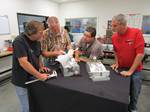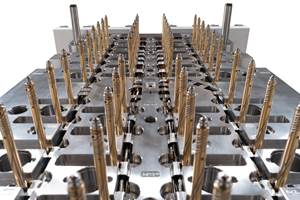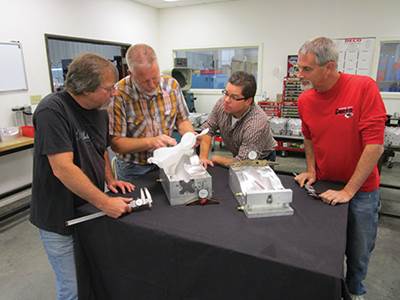A Conversation with Creative Blow Mold Tooling
This company builds plastic bottle blow molds for a variety of markets, with a focus on supply chain management and five-axis machining to help cut costs and lead times.
Explain how Creative Blow Mold Tooling better serves the needs of its customers through supply-chain management.
Jim Hensiek, director of business development: The market for packaging design and development is very competitive. When brand owners plan to change packaging, they want the new packaging quickly. This puts pressure on our customers to deliver, which puts more pressure on their suppliers, including us, to deliver quickly. We believe effective supply-chain management works upstream and downstream, and our approach is one of assisting customers with sourcing and managing resources for modeling, sampling and other tooling needs that are outside Creative’s scope of work. Part of this process includes the generation of mold-building spec sheets for every customer. Each spec sheet highlights 19 key areas of required specifications regarding new mold builds, mold refurbishment and mold repair, including the various machine platforms scheduled to produce the container in each plant location. The data, which also documents past mold performance, helps us continually improve on delivery timelines while also improving our customers’ ROI. At the same time, it’s also important that we stay on the cutting edge of technology to be able to provide more services in-house and reduce lead times.
Speaking of technology, how does the company use it to reduce lead times?
Creative Blow Mold: Creative invested in its first Haas UMC-750 five-axis machining center in the fall of 2015 to reduce the number of setups and cycle times on machined parts we were manufacturing for one of our customers. Previously, we were running these parts in our standard, three-axis vertical mills, which required up to five or six different setups to get one finished part. Incorporating our new five-axis capability, we completed a finished part with only two setups. This also reduced our total lead time on these parts by more than 50 percent. As we became more familiar with the capabilities of the five-axis, and more confident programming in it, we identified ways to use it to improve efficiencies in our blow mold manufacturing process, and we reduced overall machining cycle times by more than 25 percent. We also moved all angle work to the new machine tool. Historically, this work was performed using a rotary table in a three-axis vertical mill. Now, we run all the angle work concurrently with other operations on the mold face in the five-axis machining center, resulting in fewer setups and reduced overall cycle time.
In November 2016, Creative invested in a second Haas UMC-750, making it possible to process key mold components faster and with more flexibility. For example, blow molds are typically built in pairs (with a pin half and a bushing half). Having one five-axis machining center was an advantage, but we were only able to machine one cavity half at a time. With a second five-axis mill, we can now set up the pin-half cavity in one mill and the bushing-half cavity in the second mill, yielding one finished mold cavity per machining cycle, which enabled us to move the whole mold on to the next step in our mold manufacturing process while cutting our total processing time in half. We have seen lead times on certain types of blow mold projects shrink from eight weeks to as few as four weeks for the tool design and build. This is critical because it enables our customers to get sample bottles faster, secure brand-owner approval, and begin production for the brand owner. More importantly, we can pursue projects that are more complex, expand our customer base, and meet shorter delivery times. We are now pursuing five-axis machining work in new industries outside blow-mold manufacturing, including machine parts and other specialized tooling.
Describe a recent mold project that illustrates your company’s use of machining technology and project management.
Creative Blow Mold: We were recently awarded a job to build multiple sets of the same mold. One of these sets required us to build 84 molds in a short timeframe to assist a customer’s aggressive timeline. To produce such a high volume of mold components faster, we stepped back and looked at our typical machining processes to see where we could incorporate efficiencies. Some solutions included reconfiguring our workholding setups to run more parts in a single setup. We also programmed the CNC mills to run multiple operations on a part in the same cycle. For example, in a three-axis mill we had four vises set up, so we could run front, back, and two sides on each part in one cycle. Every time the machinist opened the door, a completed part came out. We had to buy more vises to make this work, but the time saved and the efficiencies of the setup paid off. This new approach was significant for us. We also utilized the five-axis mills to machine five sides of each cavity half, including angle work, in a single setup. The five-axis mills were key to our ability to keep the mold cavities moving efficiently through our shop.
This job also stretched our scheduling capabilities as we had to make sure we could take care of other customer requirements at the same time. We use Excel for scheduling, so as we ran through the first couple of cycles on each process for each part, we recorded those times (setup/part change/cycle time). We could then extrapolate those times over the remaining parts and set production goals for each shift. In the end, we delivered all the mold sets ahead of schedule, making our customer happy, and we gained the benefit of identifying valuable process improvements.
Related Content
What is Scientific Maintenance? Part 2
Part two of this three-part series explains specific data that toolrooms must collect, analyze and use to truly advance to a scientific maintenance culture where you can measure real data and drive decisions.
Read MoreMaking Mentoring Work | MMT Chat Part 2
Three of the TK Mold and Engineering team in Romeo, Michigan join me for Part 2 of this MMT Chat on mentorship by sharing how the AMBA’s Meet a Mentor Program works, lessons learned (and applied) and the way your shop can join this effort.
Read MoreHow to Solve Hot Runner Challenges When Molding with Bioresins
A review of the considerations and adaptations required to design hot runners and implement highly productive injection molding operations.
Read MoreThe Role of Social Media in Manufacturing
Charles Daniels CFO of Wepco Plastics shares insights on the role of social media in manufacturing, how to improve the “business” side of a small mold shop and continually developing culture.
Read MoreRead Next
Improve Profitability with Supplier Collaboration
Developing a strong and effective supply chain can benefit both the moldmaker and its customers.
Read MoreHow to Use Continuing Education to Remain Competitive in Moldmaking
Continued training helps moldmakers make tooling decisions and properly use the latest cutting tool to efficiently machine high-quality molds.
Read MoreReasons to Use Fiber Lasers for Mold Cleaning
Fiber lasers offer a simplicity, speed, control and portability, minimizing mold cleaning risks.
Read More


















